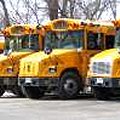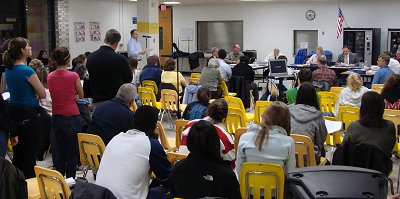- By Dan Veaner
- News
 Print
Print  Only a week after a highly charged meeting on the Lansing school budget the Lansing High School cafeteria filled Monday to continue the debate. Many speakers, particularly teachers and students criticized the list of proposed cuts, that, along with reserve funds and a $400,000 appropriation of funds collected but not spent in this year's budget, may have to make up more than a $2 million gap caused by rising costs and lost revenue. Two lists of cuts have been suggested. $927,500 of the first tier of cuts was reduced to $802,000 this week, with a second tier amounting to about half that amount.
Only a week after a highly charged meeting on the Lansing school budget the Lansing High School cafeteria filled Monday to continue the debate. Many speakers, particularly teachers and students criticized the list of proposed cuts, that, along with reserve funds and a $400,000 appropriation of funds collected but not spent in this year's budget, may have to make up more than a $2 million gap caused by rising costs and lost revenue. Two lists of cuts have been suggested. $927,500 of the first tier of cuts was reduced to $802,000 this week, with a second tier amounting to about half that amount."We all support the schools and the teachers and we don't want to see any programs effected negatively," began School Board President Anne Drake. "However we also must consider the needs of the taxpayers. Due to the severe economic conditions both this year and in the foreseeable future, I support the proposed tier one reductions. I trust the administration will do everything they can to minimize the effect on programs."
Many speakers argued for keeping teachers, including students who spoke live and on a video that was made by students. A few argued for sparing strapped taxpayers large tax rises. Superintendent Stephen Grimm presented facts and figures showing that the proposed cuts will not hurt current programs nearly as significantly as generally believed. And board members struggled with the target budget number they felt the school needs and the community might bear.
"We all have to start looking outside the box from the way things have been done in the past several years," Drake said. "We all hate change, but in order for us to keep moving forward and continue on with our excellent programs we will have to change the way things have been done. While I know that we are not voting on the tax rate, given our circumstances personally I don't think I could support anything higher than a 5% increase. Even that will be difficult to swallow and hard to pass."
Lansing Faculty Association President Stacie Kropp fought back against criticism of teachers from the district community and a suggestion in last week's Lansing Star editorial that teachers might use the adversity to be creative about delivering Lansing's historically high quality of education in new and innovative ways.
"We were admonished for not grasping onto the golden ring of opportunity that has presented itself to us in the form of cuts to our teaching staff," she said. "Opportunity for what? To change the face of Lansing's middle school and high school permanently. There's an old adage that says, 'if it ain't broke don't fix it.' What exactly is broken in the way in which we deliver academics in Lansing?"
But long time resident David Dubin had a different take on the situation. While he said he is a public education booster he noted that the school he attended in New York City averaged about 40 students per classroom.
"We graduated the most productive generation on earth," he said. "We're talking about raising class sizes from 17 to 20. Gee, students can't schedule an appointment instead of just walking in? It doesn't sound like a big sacrifice. People will have to push a little harder. That's OK. We all know we're going to have to pay more taxes, but there has to be a balance."
Dubin noted that the lines at the Lansing Food Pantry have become long and the pantry's ability to keep food on the shelves diminished by a growing number of local families struggling to keep their homes and jobs, if they still have jobs. He said that these people are less likely than teachers and students to come to a board meeting and speak out publicly.
"John Kenneth Galbraith wrote about the 'other America.' There's another Lansing," Dubin said. "It's not represented here. That's typical. It's a voiceless group. It's 50% of Lansing. They fall below any kind of ability to even pay the taxes they are being levied now. And they don't speak out. I've heard from tenured teachers and tenured professors who receive nice salaries, benefits, security. You're not going to hear from 50% of Lansing tonight just as the country didn't hear from John Kenneth Galbraith's 50% of America. And we're still not hearing from them."
Grimm and School Business Administrator Mary June King reviewed the problems the district faces in light of severe state aid cuts, and a significant reduction of revenue from Lansing's largest taxpayer, AES Cayuga. A recent Payment In Lieu Of Taxes (PILOT) agreement with Tompkins County reduces the coal-driven power plant's assessment so significantly that the school district alone will lose about a half million dollars in revenue.
Despite criticism from speakers at the meeting Grimm defended the proposed teacher cuts by sharing a detailed analysis of how they will effect class size next year as compared to this year. While he acknowledged that the cuts will mean that each teacher is responsible for more students he illustrated that class sizes would not be significantly different. He presented a detailed spreadsheet showing each section of each class offered, and noted that AP classes would be preserved.
For example, this year there are four sections of 12th grade English. Class sizes range from a low of 16 to a high of 25. Grimm showed how keeping the four sections would result in two sections of 16 students and two of 17. Dropping a section would mean three sections of 22 students. 4.2 teachers would teach an average of 95.5 students in six sections each, with 25 total sections needed in the high school English department. That accounts for a reduction of .8 of a position in that department.
Kropp said that teachers have been and continue to alternatives to cutting teachers, saying that not all of those ideas have appeared on the cut list. Kropp said teachers have suggested lowering school building heat and use open-source software. She said these things haven't appeared on cut lists.
"I am going to take an extremely unpopular position," School Board member Michael Cheatham said. "I'm going to ask that all employees in the school district voluntarily take a freeze in pay. If all employees do it will save $250,000."
The board voted to have Grimm approach the three bargaining units to ask for the voluntary freeze. Board member Richard Thayler was asked to come up with language for the resolution, and he said that he thought the idea is a good one.
"We have a problem we didn't create," he said. "The taxpayers here didn't create it. The problems were caused in Albany and Washington. If we're going to face them they should be faced equally. The Governor has suggested that the salaries we pay for our staff and teachers is 60% more than what is being paid in other states."

Dan Ferguson address the Board of Education
"Mr. Cheatham sent a challenge and I can only respond by myself for myself," said high school social studies teacher Dan Ferguson. "We as teachers thing the education program here is that important. I take your challenge. I offer a pay freeze of my salary. This needs to be a sacrifice shared across the district. All of us are willing to share that sacrifice. I think we have offered other ways such as freezing text book purchases and $30,000 in curriculum development we gave up last year."
Cheatham also recommended more cuts to athletics, replacing school budget-funded sports with a 'pay for play' plan, with booster clubs raising money for students who couldn't afford the fees. He also suggested not mowing non-horizontal surfaces on the school campus to see if it would save money.
Grimm reminded the board that whatever they do this year they will be facing more cuts in state aid next year.
"Part of the strategy that I'm employing is trying to back-fill the state aid hole," he said. "It's about $866,000 dollars. Next year it could be around $700,000, we think."
Board member Glenn Cobb said it is important top preserve academics and sports to attract new residents who might make up the difference in taxes on new homes. He said he would support the higher $24.6 million budget number, and that if that doesn't pass to bring a lower budget to the second vote. That would raise the tax levy 2.38% and the tax rate 8.57%. Board member Glenn Swanson agreed with the $2.4 million target.
"We've had two meetings here," said board member Glenn Sawnson. "The vast majority of the input we've gotten here is from people who said 'don't cut -- it's important to us."
Board member David Dittman advocated more budget cuts now to prevent having to cut drastically next year and in following years. He said he wants to target $24.3 million, raising the levy 0.56% and the tax rate 6.64%. Drake said she would agree to $24.3, though she personally couldn't support a rise that high. Cheatham said he would support $24.0 million. Grimm noted that the difference between $24.6 and $24.3 is that the lower figure forces the district to make cuts within three months, while the other number allows more time to decide.
"We can't do it in isolation," he said. "We really need to be thinking about next year, too. Your problem is that we spend too much given the revenues we have. If you're going to do it make the considered cuts now. Save the pain next year."
Board members and Grimm noted that specific cuts don't really need to be decided now. The amount of money to be spent is the issue that has to be put on the May ballot, so in the way it will be spent technically doesn't have to be exactly decided now.
The board remained split on the budget number they wanted, but agreed that they would not go higher than a $24.6 million budget. Drake's statement seemed to sum up the challenge the board faces, putting together all the pieces of stakeholder groups while balancing a budget in which spending wants are significantly unbalanced by expected revenue over the next four or five years.
"The community has been so tremendously supportive of us and we cannot turn out back on them when so many people are hurting financially," Drake said. "We are all in this together. The Board has worked very hard to build trust and integrity and I do believe that we are able to provide the highest quality education regardless of our financial difficulties. We are a strong community and will remain a strong community."
----
v6i13



